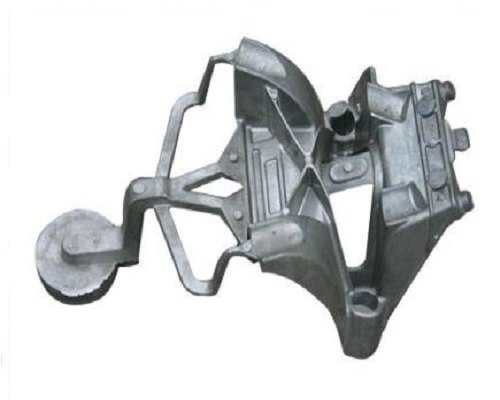Aluminum alloy die casting Mold
Aluminum alloy die casting is a popular manufacturing process that uses high-pressure injection to produce intricate, detailed parts. This process is commonly used in the automotive, aerospace, and electronics industries due to its strength, durability, and versatility.
At Haifu Mould, we specialize in creating custom aluminum alloy die casting molds that meet the specific needs of our clients. With years of experience and state-of-the-art technology, we can produce high-quality molds that are both efficient and cost-effective. In this article, we’ll dive into the process of aluminum alloy die casting, share some important processing notes, discuss its uses, and explain how Haifu Mould can help you create the perfect mold.
The Process of Aluminum Alloy Die Casting:
Aluminum alloy die casting is a complex process that requires specialized equipment and skilled technicians. The process may be broken down into the following steps:
Creating the Mold: The first step in the process is to create a mold of the desired part. This is typically done using computer-aided design (CAD) software and a CNC machine to mill the mold. The mold is made of two parts: the cover and the ejector. The cover is where the molten aluminum will be injected, and the ejector is used to remove the part from the mold once it’s cooled.
Preparing the Alloy: Once the mold is created, the next step is to prepare the aluminum alloy. The alloy is typically made up of aluminum, magnesium, and other metals. The alloy is melted in a furnace and then injected into the mold under high pressure.
Injecting the Alloy: The molten alloy is injected into the mold using a high-pressure injection machine. The machine applies pressure to the alloy to ensure that it fills the mold completely and evenly. The pressure also helps to ensure that any air pockets are removed from the mold.
Cooling and Ejecting: Once the alloy has been injected, it is left to cool and solidify in the mold. Depending on the size and complexity of the component, this might take anywhere from a few seconds to a few minutes. Once the part has cooled, it is ejected from the mold using the ejector.
Processing Notes:
When it comes to aluminum alloy die casting, there are several important processing notes to keep in mind. Some essential considerations are as follows:
Mold Design: The design of the mold is crucial to the success of the process. The mold should be designed to ensure that the alloy flows smoothly and evenly, and that any air pockets are eliminated. The mold should also be designed to minimize the risk of porosity and other defects.
Alloy Selection: The selection of the alloy is also important. The alloy should be chosen based on the desired properties of the part, such as strength, corrosion resistance, and heat resistance.
Surface Treatment: Once the part has been cast, it may require additional surface treatment to improve its appearance or performance. Surface treatment options include anodizing, plating, painting, and powder coating.
Uses:
Aluminum alloy die casting is a versatile process that can be used to produce a wide range of parts. Here are some common uses for aluminum alloy die casting:
Automotive Parts: Aluminum alloy die casting is commonly used to produce parts for the automotive industry, such as engine blocks, transmission cases, and suspension components.
Aerospace Parts: Aluminum alloy die casting is also used to produce parts for the aerospace industry, such as engine components, structural parts, and landing gear.
Post-processing of Aluminum Alloy Die Casting
After the aluminum alloy die casting is completed, post-processing is necessary to achieve the desired surface finish and functional properties. The post-processing steps may include trimming, deburring, shot blasting, sandblasting, polishing, anodizing, and painting.
Trimming and deburring are the first steps in post-processing. Trimming involves removing the excess material around the casting using cutting tools. Deburring involves removing the sharp edges and burrs from the casting using a grinder or a sanding tool. Shot blasting and sandblasting are used to remove the surface imperfections and improve the surface finish of the casting.
Polishing is used to achieve a mirror-like finish on the casting. Anodizing is an electrochemical process used to enhance the corrosion resistance of the casting and improve its appearance. Painting is used to add color and protect the casting from the environment.
Advantages of Aluminum Alloy Die Casting
Die casting an aluminum alloy has various benefits over competing methods. These advantages include:
- High production rate: Die casting of aluminum alloy is a rapid manufacturing technique that can produce significant quantities of components in a brief period of time.
- Design flexibility: Aluminum alloy die casting allows for complex geometries and thin walls to be produced with high accuracy and repeatability.
- Strength and durability: Aluminum alloys have excellent mechanical properties, including high strength-to-weight ratio, corrosion resistance, and thermal conductivity.
- Surface finish: Aluminum alloy die casting produces parts with excellent surface finish and dimensional accuracy.
- Cost-effective: Aluminum alloy die casting is a cost-effective manufacturing process, especially for high-volume production.
Conclusion
Die casting of aluminum alloy is a versatile and cost-effective manufacturing method that offers a number of advantages over other manufacturing processes. Haifu mould is a professional manufacturer of aluminum alloy die casting molds and offers comprehensive services from design to production. With years of experience and expertise, Haifu mould can produce high-quality aluminum alloy die casting molds that meet customer requirements and industry standards. By working with Haifu mould, customers can enjoy the benefits of aluminum alloy die casting and produce high-quality parts for various applications.

